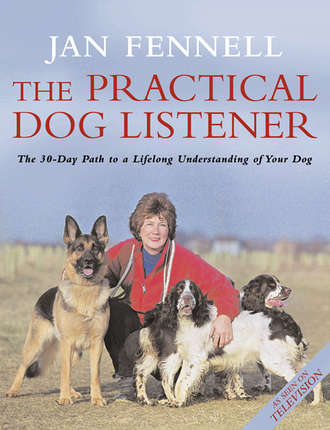
Полная версия
The Practical Dog Listener: The 30-Day Path to a Lifelong Understanding of Your Dog
When the wolf, Canis lupus, integrated itself into human society, the two species formed a unique partnership. Their relationship was so special that burial chambers have been unearthed containing the skeletons of men and dogs buried alongside each other. Both were hunter-gatherers, both were communal. Both understood instinctively that survival was dependent on the power of the pack. Since then, this new strain of wolf, Canis familiaris, has evolved into a multitude of breeds. Just as the roots of the entire European population can supposedly be traced to seven women, so every dog – from the Pekinese to the Saluki, the Akita to the Alaskan husky – has a bloodline that leads back to the first domesticated dogs. At the same time, the remarkably close, instinctive relationship ancient man had with the dog has deteriorated and all but disappeared.
If we accept that Canis familiaris’ basic programming remains much the same as it was when it first left its wolf-pack environment, it is not difficult to understand the forces that mould a modern dog’s behaviour. The dog may have been taken out of the wolf pack, but the wolf pack can never be taken out of the dog.
To understand the way the modern dog views its world, we must therefore begin by looking at the society from which it first emerged and evolved: the wolf pack. For the wolf, the most powerful instincts are survival and reproduction. Driven by these instincts, the species has evolved a hierarchical system as strict and successful as any in the animal world. Every wolf pack is made up of leaders and subordinates, and at the head of every pack’s pecking order are the ultimate rulers, the Alpha pair.
As the strongest, healthiest, most intelligent and most experienced members of the pack, it is the Alpha pair’s job to ensure the pack’s survival. As a result, they dominate and dictate everything the pack does, and their status is maintained by consistent displays of authority. Underlining this, the Alpha pair are the only members of the pack who breed, thus ensuring only the healthiest genes survive. They are, in effect, twin dictators. They control and direct life within the pack, and the remainder of the pack accepts that rule unfailingly. Each subordinate member is content to know its place and function within this pecking order. Each lives happily in the knowledge that it has a vital role to play in the overall wellbeing of the pack.
The hierarchy of the pack is constantly reinforced through the use of highly ritualised behaviour. The ever-changing nature of pack life, in which Alphas and their subordinates are frequently killed or replaced through age, makes this essential. As far as the wolf’s modern-day descendants are concerned, however, four main rituals hold the key to the pack instinct that lives on within them. They are central to my method.
THE FOUR RITUALS
1 The first key ritual is performed whenever a pack is reunited after being apart. As the pack reassembles, the Alpha pair remove any confusion by reasserting their dominance via clear signals to the rest of the pack. The pair have their own personal space, a comfort zone, within which they operate. No other wolf is allowed to encroach on this space unless invited to do so. By rejecting or accepting the attention of other members who wish to enter their space, the Alpha pair re-establish their primacy in the pack – without ever resorting to cruelty or violence.
2 When a kill has been made by the pack, the Alpha pair get absolute precedence when it comes to eating the carrion; the pack’s survival depends on their remaining in peak physical condition. Only when they are satisfied and signal their feed is over will the rest of the pack be permitted to eat – and then according to the strict pecking order, with the senior subordinates feasting first and the juniors last. Back at the camp, the pups and ‘babysitters’ will be fed by the hunters regurgitating their food. The order is absolute and unbreakable. A wolf will act aggressively towards any animal that attempts to eat before it. Despite the fact that the pack contains its blood relatives, an Alpha will attack any wolf that breaks with protocol and dares to jump the queue.
3 The Alpha pair repay the respect the pack bestows upon them with total responsibility for its welfare. Whenever danger threatens, it is the role of the Alpha pair to protect the pack. This is the third situation in which the natural order of the pack is underlined. The Alpha pair perform their leadership role unblinkingly, and from the front. They will react to danger in one of three ways, selecting one of the ‘three Fs’: flight, freeze or fight. Accordingly, they will run away, ignore the threat or defend themselves. Whichever response the Alpha pair select, the pack will again back up their leaders to the hilt.
4 Inevitably, the Alpha pair are at their most dominant during the hunt. Food, after all, represents the pack’s most fundamental need; its very survival depends on it. As the strongest, most experienced and intelligent members of the pack, the Alpha pair take the lead during the search for new hunting grounds. When prey is spotted, they lead the chase and direct the kill. The Alphas’ status as the pack’s key decision-makers is never more in evidence than during this process. The wolf’s prey can range from mice to buffalo. A pack may spend as long as four hours stalking, cornering and slaying its target. The logistics of this operation require a combination of organisation, determination, tactics and management skill. It is the Alpha’s job to provide this leadership. It is the job of the subordinates to follow and provide support.
A Leap of Imagination
It is little wonder that so many people encounter problems in their relationship with their dogs. The vast majority of dog owners enter that relationship having made a series of utterly false assumptions. They have assumed, for instance, that the dog is in effect a child: an incapable, illogical – if deeply lovable – dependant. As a result of this, they have also assumed that it is going to respond to a series of childlike instructions issued in their language. They are viewing the dog and its world through the prism of the human experience: they are wrong.
The dog does not understand or relate to the human experience in any way. The fact that it responds to the word ‘sit’ or ‘come’ after hearing it a thousand times does not mean that it understands the spoken human language. It has simply come to associate these sounds with certain forms of behaviour, and has learned to act accordingly.
To lead a happy and fulfilling life with dogs, all owners need to make a fundamental change in their approach. They need to look at the world from the dog’s perspective, and understand the society and the rules under which the dog believes it is living. A leap of the imagination is required. They need to understand that the dog is not an immature child operating within the human world: it is an intelligent adult operating within the structures and strictures of its own highly regulated society: the pack. And, most importantly of all, the dog believes it has been given the job of leading that pack. Viewed from this perspective, all its behaviour will make sense. And, viewed from this perspective, all owners have the opportunity to forge a new and hugely fulfilling relationship with their dog.
Amichien Bonding
A dog believes it is a functioning member of a community that operates according to principles directly descended from the wolf pack. Whether its ‘pack’ consists of itself and its owner, or a large family of humans and other animals, the dog believes it is part of a social grouping and a pecking order that must be adhered to at all times. What is more, all dogs believe they are the elected leader of that pack. And they believe this because the humans with whom they live send out signals that re-elect them to the role on a daily basis.
It is my belief that all of the problems we encounter with our dogs are rooted in their belief that they rather than us, their owners, are the leaders of their particular packs. It is the correction of this misconception that lies at the heart of the communications technique I have developed, called Amichien Bonding.
Four separate elements make up the bonding process. Each correlates to the specific times I have identified when the pack’s hierarchy is established and underlined. On each occasion, the dog is confronted with a question that we must answer on its behalf by providing clear, concise signals that it will understand. The four occasions are:
When the pack reunites after a separation, who is the boss now?
When the pack eats food, what order do we eat in?
When the pack is under attack or there is a fear of danger, who is going to protect us?
When the pack goes on the hunt, who is going to lead us?
Each set of signals will be introduced individually with the ‘hunt’, or walk, tackled last of all. It will eventually be necessary for you to use all four elements in conjunction with each other. Your dog must, in effect, be blitzed with signals. It needs to learn that it is not its responsibility to look after you, that it is not its job to care for the house, that all it has to do is sit back and lead a comfortable and enjoyable life. It is a mantra that must be repeated over and over again. Only then will your dog get the message that it is no longer in charge, only then will it be able to exercise the most powerful form of control, self-control.
The process is, at heart, a simple one. The most powerful central principles are established within the first few hours of application. From there, you will go on to add additional signals and controls, first within the home, then within the outside world. By the end of the first thirty days, you should have laid the foundations for a lifetime of companionship and co-operation. What follows is a guide to these formative, first thirty days.
In many ways, the process that is about to begin is akin to a revolution. The objective will be to stage a bloodless coup, to remove the leadership from the dog, but to do so without resorting to force or violence in any way. No coup in history has succeeded without precise and careful planning. And this one will be no exception…
TO BE OR NOT TO BE A DOG OWNER
‘There is no faith which has never yet been broken, except that of a truly faithful dog.’
Konrad Lorenz
It is no surprise to me that dogs have for centuries remained the inspiration for words like these. The love, loyalty and companionship that a dog can bring into our lives are unique. And, in theory, they are pleasures that everyone should have the right to enjoy. I write ‘in theory’ because I do not, in all honesty, believe it is a right that should be granted automatically. It is a sad fact of life that there are people who take dogs into their home for all the wrong reasons. The animal sanctuaries and dogs’ homes of the world are filled with the unhappy results of their rash and unthinking behaviour.
It has become a cliche to say that a dog is not for Christmas, it is for life. But it remains true nevertheless. A dog brings with it a set of responsibilities. And no one should take on the task of introducing a dog into their home without weighing up whether they are ready, willing and able to live up to these responsibilities.
There have probably been thousands of books written on the pros and cons of taking on a dog. I do not intend to contribute another one. Having said that, I do have some opinions on the matter. Anyone who is only getting a dog for their children to play with should not get a dog. Dogs and young people can forge the most beautiful relationships of all – but only if the child is taught to respect the dog: they are not toys. Anyone who is getting a dog solely for the purpose of guarding their homes should not get a dog: this is not fair. Anyone who intends getting a dog and then leaving it at home all day should think again, or should make appropriate arrangements for a friend or professional walker to take it out. The dog is a social animal and, if it is cut off from other beings for eight to twelve hours, this is not good for it.
I also believe that all owners must prepare themselves for the reality of dog ownership. It is the easiest job in the world when the dog is a lovable ball of fluff and affection, but what about when it falls ill or misbehaves, fouls the living-room carpet or growls at visitors? And what about heading out into the outside world? Are you prepared to head out on cold, inhospitable winter mornings to walk the dog? Are you willing to become a fully paid-up member of the plastic-bag brigade and clean up after your dog in public? And what about the time it falls ill and you face the potentially astronomical vet’s bills?
Of course, good owners – rather like good parents – think about a lot of these things instinctively. But I would ask even these genuine dog lovers to do a little soul-searching before committing themselves to using my method. It is one thing to understand the challenges of my approach from the human point of view, but what about thinking about this from the dog’s perspective? Dogs are living, breathing creatures with needs and feelings of their own. No one would welcome a deaf person into their family without accepting in advance that they would need to learn some form of sign language. It is no different with a dog. So, for this reason, I would ask you to consider the following:
Are you prepared to go into this with an open mind?
Are you willing to forget and discard all other ‘training’ methods?
Are you prepared to accept the dog’s welfare is paramount?
Are you prepared to work hard and make the sacrifices necessary to understand a language that may prove elusive and confusing at times?
Are you prepared to give the time the dog needs, especially during the early stages when patience and perseverance are of primary importance?
Has the whole family discussed what is going to be required?
If you already own dogs, are you prepared to go through the necessary retraining they will need as well?
These are all tough questions. I make no apologies for posing them, however. I much prefer that people understand their dogs before they learn to love them. I would rather they begin knowing that sacrifices and hard work will be required. Yet, if my years of experience have taught me anything, it is that the effort is far, far outweighed by the rewards that come from having a happy, well-adjusted and relaxed dog.
WHERE TO GET A DOG
To my mind, there are only two sources from which we should buy dogs: respectable, responsible breeders and registered rescue centres or dogs’ homes. There is, I know, a wide range of alternative sources, from pet shops to so-called licensed kennels. Yet I would not recommend that a dog be taken from any of these, for the following two reasons.
Firstly, it is my firm belief that, if at all possible, an owner should be able to see the dog’s mother and gain knowledge of the history of both parents before taking the dog away. This is something I will explain in more detail in a moment. Secondly, it is only through the first two sources that an owner will have any comeback.
As an illustration of this latter point, I often use the example of a close friend of mine, Wendy Broughton. Wendy is a keen horsewoman. It was Wendy who introduced me to Monty Roberts, the Horse Whisperer, from whom I learnt so much. At a horse fair one day, Wendy saw a batch of dogs for sale for £15 each. There were no clues as to where these dogs had come from. Their owners that day had only one interest: making money. Wendy is a soft touch and took pity on one dog in particular. In the two years since then, she has spent more than £2500 on vet’s bills. It turned out the dog was riddled with worms and suffered from a variety of stomach problems.
The crucial point here is that Wendy had no comeback on the people who sold her that dog; she didn’t even get a contact name. This type of trade is sadly on the increase. The growth of ‘puppy farms’ is something I abhor. Often, owners will be allowed no more than seventy-two hours in which to return their dogs.
In contrast, no reputable breeder or rescue centre would sell a dog without guaranteeing that you could return the animal to them if there were a medical problem or if you were, for whatever reason, unhappy with it. Indeed, a good breeder would insist on being on hand to provide advice throughout the dog’s days. The dog cannot lose under this arrangement: if it fits into a happy home, it will enjoy a long and hopefully rewarding life there. If not, it will return to a place where its best interests are safeguarded. Owners who leave themselves with no comeback, are left with no obvious place to return an unwanted dog. Many will, of course, ensure they are given good homes. Sadly, many more will not.
Buying a Puppy
Falling in love with a puppy is the easiest thing in the world. We’ve all experienced the ‘aaah’ factor, that moment when we’ve stared for the first time into the saucer-sized eyes of a sweet, young dog and gone hopelessly gooey. It’s for this reason that I recommend you begin your search for a puppy by steering clear of these charmers to begin with. You know that you are going to fall head over heels in love with the puppy – it’s a given. Far better for you to deal with the realities before beginning the romance, and the best way to do this is by first meeting the family.
Producing a litter of puppies involves collaboration between the human breeder and their dogs. The dogs deliver this new life into the world, but it is the human who must shoulder the ultimate responsibility. I passionately believe that the best way to assess whether a dog is coming from a good home is by meeting both sets of ‘parents’, that is both the human and canine carers.
Given that many breeders go to a stud to begin their litters, it is more than likely that only the mother will be available. The condition of the owner and its home, its personality, temperament and general demeanour will reveal much. Of course, part of the equation is missing if the father is not there. Seeing both will provide the clearest idea possible of the sort of dog their offspring is going to become, nevertheless, a visit to the mother will always be worthwhile.
Just as importantly, the attitude and behaviour of the owner is highly revealing too. If, for instance, the mother is not with its puppies, there are immediate reasons for concern. The growth of puppy farms is one of the more unpleasant facts of life these days. The absence of the mother may mean that the seller is a third party, whose motives are purely to do with money rather than the welfare of the dogs in their protection.
Another good indicator of the quality of the home is the extent to which the seller interrogates all potential new owners. A potential buyer should expect to be grilled by a good breeder: I know, as I always insist on finding out as much as I can about anyone who wants to take one of my puppies into their home. The procedure should be like that of an adoption society being very careful about where it places the children entrusted to its care. Good breeders should be just as diligent in finding a home for the innocent young lives for which they are responsible.
A reputable breeder should want to know everything about the home into which they are considering releasing the puppy. They should want to know what the domestic situation is at home: are there people around all day to look after the dog? Are there many small children in the home? Has the prospective owner owned this type of dog, or indeed any dog, before? Another important question is whether the prospective owner has thought about whether a particular breed is right for their home. Also, are they willing to wait for a puppy? Good breeders do not churn out dogs as if from a production line. If the breeder asks these questions, it should be seen as a positive sign. If they do not, they are probably more interested in making a sale and should therefore be treated with caution.
By the same token, a good breeder should be open to questions from a potential owner. They should be willing to reveal anything and everything about the dog’s history and background, from the details of its parentage and its age, to its favourite food and toys. Again, owners should be wary of anyone who is vague or unhappy about answering these questions. I’ve never been afraid to talk to potential owners in this kind of detail. Indeed, I’ve made very good friends of people who have bought puppies from me.
Potential owners should be particularly careful about checking for hereditary problems within some breeds. Cavalier King Charles spaniels can be prone to heart problems, for instance; Dalmatians can suffer from deafness; long-backed breeds, like basset hounds and dachshunds, have a tendency to suffer from back pain and slipped discs. With German shepherds and Labradors, potential buyers should look out for hip dysplasia, a genetic problem in which the ball-and-socket joint of the hip can be deformed or even nonexistent. It is a condition that is extremely painful and ultimately crippling for dogs that are afflicted and something that good breeders monitor closely. Dogs are x-rayed at the age of one and given a ‘hip score’, which ranges from zero for perfect hips, to eighteen and higher, a mark that indicates the dog should not be used for breeding.
All good breeders work hard to eliminate these problems. But, so as to make informed and appropriate choices, potential owners are well advised to thoroughly research the breeds they are interested in. This is easily done through the Kennel Club or its equivalent organisation, and then through the various breed experts. The importance of this cannot be overstressed. No one goes out to make a major purchase like a new car or a house without checking out the subject thoroughly. When they choose a dog, owners are introducing into the family a new member that will hopefully remain with them for twelve to fourteen years; it is not something to be taken lightly.
Rescue Dogs
Few things can compare with the pleasure that comes from providing a home for a rescue dog – that is, a dog that has been placed in a sanctuary or dogs’ home due to abuse, abandonment or bad behaviour. As someone who has taken in a number of rescue dogs over the years, I can say with my hand on my heart that the rewards both the dogs and I have had have been phenomenal. The joy I have had in seeing tragic dogs given a new hope in life has been immense. And I have to admit it has made me feel good to have provided these dogs with a happy and stable home life they had previously been denied.
Having said that, there is no escaping the fact that rescue dogs can present considerable problems, for self-evident reasons. I often say that there is no such thing as a problem dog, but there are dogs with problems. And rescue dogs, by their very nature, come with more problems than most.
Obviously in such cases it is simply not possible to make the checks that are possible with a new puppy. Any decent sanctuary or rescue organisation should be able to provide you with some details about the dog’s immediate past. Again, vagueness or reluctance to give out details should be regarded with extreme caution, however, the vast majority of sanctuaries and rescue homes are run by people who have an extraordinary dedication to dogs and their welfare. Whatever they know about the dog, they will be willing to tell you: good or bad. It is not in their interest, or that of the dog, to deceive you. The reason many dogs are in a sanctuary is due to violence. I believe, however, that, provided you understand the way a dog’s mind works, it is a calculated risk. For many people, I hope it will remain a risk worth taking.









